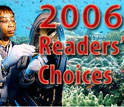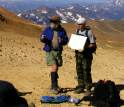 |
NSF Awards
First Partnership for International Research and Education Grants
-- NSF’s Partnership for International Research and Education
program awarded its first grant. The program is designed to enable
U.S. scientists and engineers to build strong, long-lasting international
research collaborations and to help the nation develop a new cadre
of globally engaged U.S. scientists and engineers. -- January 30,
2006 -- Full
story
|
Accelerating
Loss of Ocean Species Threatens Human Well-Being -- An international
group of ecologists and economists showed that the loss of biodiversity
is profoundly reducing the ocean's ability to produce seafood, resist
diseases, filter pollutants and rebound from stresses such as overfishing
and climate change. -- November 2, 2006 -- Full
Story
|
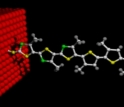 |
Device Only Atoms Across
May Allow Infinitesimal But Powerful Computers -- Using the
power of modern computing combined with innovative theoretical tools,
an international team of researchers determined how a one-way electrical
valve, or diode, made of only a single molecule does its job. --
April 3, 2006 -- Full
story
|
NSF Report
Reveals Century of Doctoral Education Trends in the United States
-- A report released by NSF documented rapid growth and changing
demographics of doctoral education during the 20th century, especially
over the last 25 years. “U.S. Doctorates in the 20th Century”
highlighted many factors about who is educated and where. The report
also describes the complex changes taking place in the pursuit of
doctoral degrees, many of which are in new interdisciplinary fields.
-- October 10, 2006 -- Full
Story
|
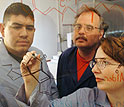 |
Top Researcher-Educators
Receive the Presidential Early Career Award for Scientists and Engineers
-- The White House honored 20 NSF-supported researchers with the
Presidential Early Career Award for Scientists and Engineers, one
of the most prestigious awards given to investigators in the early
stages of promising research and education careers. -- July 26,
2006 -- Full
story
|
Self-Cooling
Soda Bottles? -- Every day, the sun bathes the planet in
energy--free of charge--yet few systems can take advantage of that
source for both heating and cooling. Now, researchers are making
progress on a thin-film technology that sticks both solar cells
and heat pumps onto surfaces, ultimately turning walls, windows
and maybe even soda bottles into climate-control systems. -- July
11, 2006 -- Full
story
|
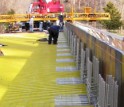 |
Easy Up, Not-So-Easy
Down -- Using new fiberglass-polymer materials, contractors
in Springfield, Mo., subjected a decaying, 70-year-old bridge to
a makeover that was as quick as it was dramatic. Instead of snarling
traffic for two to three weeks while they repaired the crumbling
deck, girders and guardrails by conventional methods, the workers
used prefabricated plates and cages developed by an NSF-supported
university-industry partnership to finish the job in a mere five
days. -- March 2, 2006 -- Full
Story |
Closer to
Home -- Using a relatively new planet-hunting technique that
can spot worlds one-tenth the mass of our own, researchers have
discovered a potentially rocky, icy body that may be the smallest
planet yet found orbiting a star outside our solar system. -- January
25, 2006 -- Full
Story
|
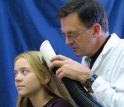 |
'LouseBuster' Instrument
Shown to Kill Head Lice -- Biologists invented a chemical-free,
hairdryer-like device--the LouseBuster--and conducted a study showing
it eradicates head lice infestations on children by exterminating
the eggs, or "nits," and killing enough lice to prevent
them from reproducing. -- November 6, 2006 -- Full
Story |
Global Warming
Can Trigger Extreme Ocean, Climate Changes -- Newly published
research provided evidence that global climate change may have quickly
disrupted ocean processes and may lead to drastic shifts in environments
around the world. Although the events described unfolded millions
of years ago and spanned thousands of years, the researchers, affiliated
with the Scripps Institution of Oceanography, say they provide one
of the few historical analogs for warming-induced changes in the
large-scale sea circulation, and thus may help to illuminate the
potential long-term impacts of today's climate warming. -- January
4, 2006 -- Full
Story
|
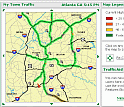 |
Real-Time Traffic Routing
from the Comfort of Your Car -- Engineers developed a system
for turning anonymous cell-phone location information into an illuminated
traffic map that identifies congestion in real time. The system
takes advantage of the steady stream of positioning cues--signals
all cell phones produce, whether in use or not, as they seek towers
with the strongest signals. It is the first traffic-solution technology
that monitors patterns on rural roads and city streets as easily
as on highways. -- August 30, 2006 -- Full
Story |
A Link Between
Rainfall and Magnetism -- Scientists gained a deeper insight
into rainfall patterns and atmospheric dynamics by using techniques
originally developed for magnetic materials. Physicist Ole Peters,
of the Santa Fe Institute and UCLA, and climatologist J. David Neelin
of UCLA argue that the onset of intense tropical rain can be described
by the same mathematics as a piece of iron that is making the transition
from unmagnetized to magnetized. -- June 29, 2006 -- Full
story
|


